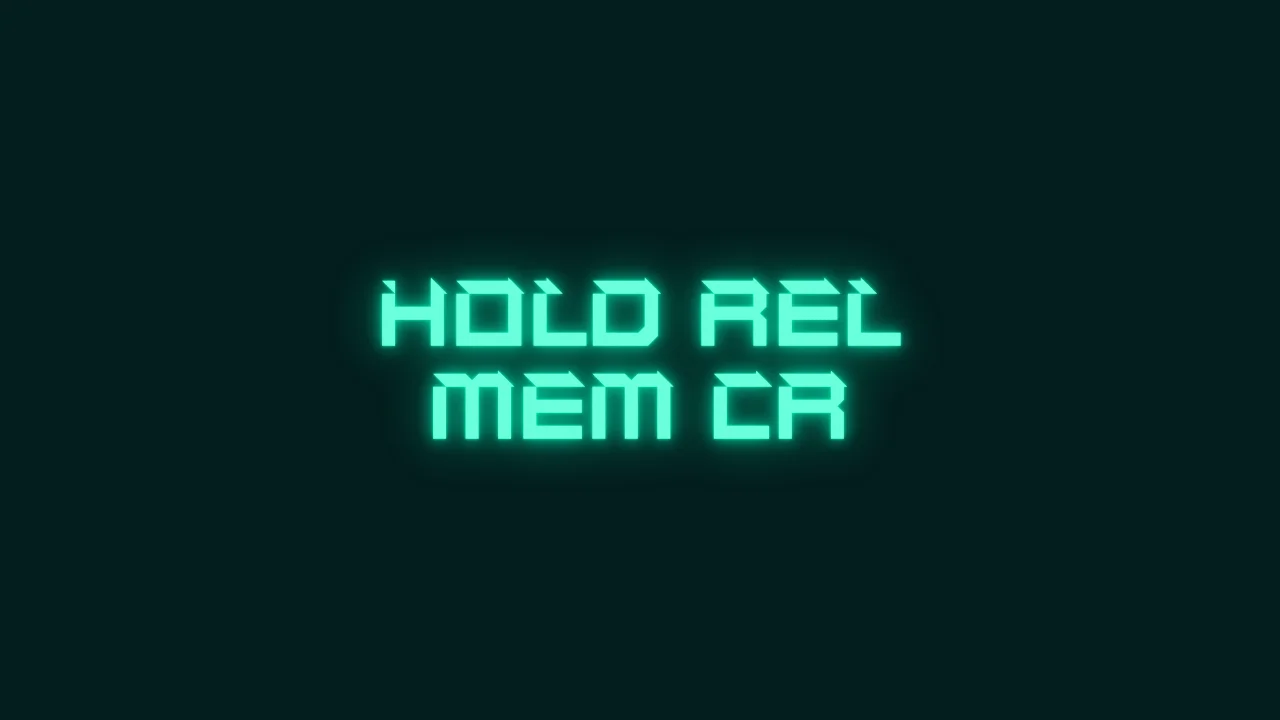Hold Rel Mem Cr
You’re checking your Chase Bank account, and there it is: “hold rel mem cr.” It’s cryptic, confusing, and maybe a little alarming. Why is there money on hold in your bank account? What does this term even mean? Don’t worry—I’ve been there, staring at a bank statement like it’s a puzzle. In this guide, I’ll break down everything about hold rel mem cr, why it happens, and how to deal with it. By the end, you’ll feel confident navigating these bank holds like a pro.
What Is Hold Rel Mem Cr?

Let’s start with the basics. Hold rel mem cr stands for “hold release member credit.” It’s a term Chase Bank uses to describe a temporary hold on funds in your account, often tied to a deposit or transaction. The bank places this hold to verify the transaction before releasing the funds. Think of it as the bank’s way of saying, “We see your money, but we need a moment to double-check.”
Why Banks Use Holds
Banks like Chase use holds to protect themselves and you. A bank deposit hold ensures the deposited funds are legitimate. For example, if you deposit a check, the bank may hold the funds until the check clears. This prevents fraud or bounced checks. It’s a safety net, but it can feel frustrating when you need those funds now.
Common Scenarios for Hold Rel Mem Cr
You might see hold rel mem cr in several situations. Depositing a large check? The bank might hold it. Made a big purchase? A pending bank hold could appear. Sometimes, it’s just a routine verification. I once deposited a birthday check from my grandma, only to see a hold—it was annoying, but it cleared in a day.
How Long Do Holds Last?
Most bank account holds last 1–7 business days, depending on the transaction. For checks, Chase’s policy typically releases funds within 1–2 days for local checks, longer for out-of-state ones. Cash deposits often clear faster. If it’s a hold rel mem cr pending, check your account regularly—it might resolve quicker than you think.
Chase’s Hold Policy Explained
Chase’s bank hold policy varies by account type and transaction. For example, new accounts often face stricter holds. Large or unusual deposits also trigger scrutiny. If you’re wondering, “Why did Chase put my deposit on hold?” it’s likely due to their risk management system. Always check Chase’s website or call customer service for specifics.
| Deposit Type | Typical Hold Duration | Notes |
| Cash Deposit | Same day or next day | Usually clears quickly |
| Local Check | 1–2 business days | Depends on bank verification |
| Out-of-State Check | 3–7 business days | Longer due to clearing process |
| Large Deposit | Up to 7 business days | May require extra review |
Why Is There Money on Hold?
Seeing funds on hold can be stressful, especially if you need the money. Let’s explore why this happens and what it means for you. In my experience, these holds are more common than you’d think, but they’re usually temporary.
Fraud Prevention Measures
Banks use holds to prevent fraud. If you deposit a check, the bank needs to ensure it’s valid. A temporary bank hold protects against fake checks or errors. Chase’s system flags unusual activity—like a deposit that’s much larger than your typical transactions.
Transaction Verification Delays
Sometimes, a pending bank hold appears because the bank is verifying a transaction. For example, if you deposit a check via mobile banking, it might take a day or two to process. This is especially true for hold rel mem cr pending entries, which show the bank is still reviewing.
Account Status Impact
Your account history matters. New accounts or those with low balances might face stricter Chase deposit delays. If you’ve had overdrafts, the bank may be extra cautious. A Reddit user on a thread about hold rel mem cr but funds are available mentioned their hold cleared once they verified their identity with Chase.
External Factors
External issues, like delays from the issuing bank, can cause holds. For instance, if you deposit a check from a small credit union, it might take longer to clear. Bank hold duration depends on how fast the banks communicate. Patience is key here.
How to Get a Hold Removed
Wondering, “How do I get a hold removed from a deposit?” You’re not alone. I’ve called my bank in a panic before, only to learn there are simple steps to speed things up. Here’s how to tackle a hold rel mem cr.
Contact Chase Customer Service
Call Chase at 1-800-935-9935 or visit a branch. Explain the hold rel mem cr charges or pending status. Be ready with your account details and transaction info. A friendly tone goes a long way—I’ve found that being polite gets faster results.
Verify Transaction Details
Provide proof, like a deposit receipt or check stub. If it’s a hold memo dr Chase, confirm the source of the funds. For example, if you deposited a payroll check, show a pay stub. This can help clear bank hold faster.
Build a Strong Account History
Maintain a healthy account to avoid future holds. Regular deposits and avoiding overdrafts build trust with Chase. What I learned the hard way is that consistent banking habits reduce scrutiny. Over time, you’ll see fewer bank account freezes.
Request an Exception
If you need funds urgently, ask for a hold release. Chase may make an exception, especially for verified deposits. Be honest about your situation—maybe it’s a medical bill or rent. This worked for me once when I needed cash for an emergency.
Monitor Your Account
Check your account daily via Chase’s app or website. Sometimes, a hold release memo credit appears quietly, and funds become available. Set up alerts to stay informed about Chase hold removal updates.
| Action | How It Helps | Timeframe |
| Call Chase | Clarifies hold reason | Immediate |
| Provide Proof | Speeds up verification | 1–2 days |
| Request Exception | May release funds early | Case-by-case |
| Monitor Account | Tracks hold status | Ongoing |
Common Misconceptions About Holds
Bank holds can spark confusion, especially with terms like hold relinquished member credit. Let’s clear up some myths I’ve seen floating around, especially on Reddit threads like hold rel mem cr Chase Bank meaning reddit.
Holds Mean Fraud
Not always. A bank transaction hold doesn’t mean you’re suspected of fraud. It’s often routine, especially for large deposits. Chase’s system flags anything unusual, but it’s usually just a precaution.
Funds Are Unavailable Forever
Holds are temporary. Even if you see hold rel mem cr but funds are available, the hold might only affect part of the deposit. Most clear within days, so don’t panic.
You Can’t Do Anything
You have options. Contacting Chase or providing verification can speed up release bank hold. Don’t assume you’re stuck waiting.
All Banks Are the Same
Each bank has unique policies. Chase’s bank hold explanation might differ from Bank of America’s. Always check your bank’s specific rules.
Actionable Tips to Manage Holds
Here are 5 actionable tips to handle hold rel mem cr and avoid future headaches. These have saved me time and stress.
- Call Chase Immediately: Don’t wait—contact customer service to understand the hold’s reason.
- Keep Deposit Records: Save receipts or check images to verify transactions quickly.
- Use Direct Deposits: Payroll or electronic transfers often clear faster than checks.
- Ask About Account Upgrades: Higher-tier accounts may have fewer holds.
- Set Up Alerts: Get notified of holds or account changes via Chase’s app.
Real-Life Examples of Holds
Let’s make this relatable. Imagine you deposit a $5,000 check from a freelance gig. You see hold rel mem cr on your statement, and the funds are unavailable. Frustrating, right? This happened to a friend who called Chase, provided a contract as proof, and got the hold lifted in two days.
Another case: a Reddit user shared their story about a hold rel mem cr pending after depositing a tax refund. They waited three days, checked their account, and the funds were released without action. These stories show holds are common but manageable.
| Scenario | Hold Reason | Resolution Time | Action Taken |
| Freelance Check | Large deposit | 2 days | Provided contract |
| Tax Refund | Verification | 3 days | Monitored account |
| Cash Deposit | New account | 1 day | Called Chase |
FAQs About Hold Rel Mem Cr
What does hold rel mem cr mean?
It’s a Chase Bank term for a temporary hold on funds, often for deposit verification. It ensures the transaction is legitimate.
Why did Chase put my deposit on hold?
Chase may hold deposits to prevent fraud, verify checks, or review large transactions. New accounts face stricter holds.
How long does a hold last?
Most holds last 1–7 business days. Cash deposits clear faster, while checks may take longer.
Can I remove a hold?
Yes, contact Chase, provide proof, or request an exception. Monitoring your account helps, too.
Why are funds available but still on hold?
Some holds only affect part of the deposit. Check with Chase to confirm which funds are usable.
Is hold rel mem cr a charge?
No, it’s not a charge—it’s a temporary hold on funds, not a deduction from your account.
Read More: Epic Everest Base Camp A Journey of a Lifetime
Conclusion
Dealing with a hold rel mem cr can feel like a banking mystery, but it’s just a routine precaution. Whether it’s a check deposit or a large transaction, Chase uses holds to keep your account safe. By understanding why holds happen, contacting Chase, and following our actionable tips, you can manage or even prevent them. Here’s a tip I always give beginners: stay proactive—check your account, keep records, and don’t hesitate to call. With these steps, you’ll navigate bank holds with ease and confidence.



![One e App: Detailed Guide on Health Base Web [2024] 8 One e App](https://deeplores.com/wp-content/uploads/2023/07/One-e-App-768x432.png)



